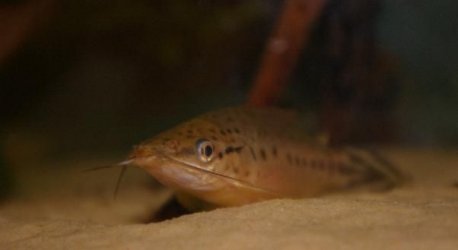bunjiweb
mmmmmmmarines
Common name: Flagtailed Catfish
Scientific name: Dianema urostriatum
Family: Callichthyidae
Origin: Brazil & other northern regions in South America in rivers and pools.
Maximum size: 5"
Care: The flagtailed catfish is a peacful community cat that doesnt grow to big. You will find they can go with almost any other fish which makes them a perfect "larger" cat to keep. They are bottom and middlewater swimmers, that you will find enjoy basking on a rock alot, Whilst swimming about together in the middle regions of the water.
- Minimum Tank size would be 20G for a pair or 30G for 3+.
- Can be quite fussy with water conditions so check your LFS parameters against your own and acclimatise them carefully.
- They like rocks or large plants to sit on / in, along with some caved areas.
Feeding: Seem to take very kindly to feeding on catfish pellets and anything else they can forrage for on the bottom of the tank. A bit of vegitable is always appreciated and keeps their colours bright.
Breeding: Similar to that of a cory. Requires Wet/Dry season simulation and feeding on live food or possibly frozen bloodworm throughout.
Sexing: Females are much fatter than the males, easily distinguishable (unless yours are very greedy and are all fat!).
Comments: I Have 2 of these and they seem very good friends, so its safe to say keep them in groups. It is usually reccomended in groups of 5+ If you have the space. Never caused or been the subject of any problems, an ideal community cat.
Scientific name: Dianema urostriatum
Family: Callichthyidae
Origin: Brazil & other northern regions in South America in rivers and pools.
Maximum size: 5"
Care: The flagtailed catfish is a peacful community cat that doesnt grow to big. You will find they can go with almost any other fish which makes them a perfect "larger" cat to keep. They are bottom and middlewater swimmers, that you will find enjoy basking on a rock alot, Whilst swimming about together in the middle regions of the water.
- Minimum Tank size would be 20G for a pair or 30G for 3+.
- Can be quite fussy with water conditions so check your LFS parameters against your own and acclimatise them carefully.
- They like rocks or large plants to sit on / in, along with some caved areas.
Feeding: Seem to take very kindly to feeding on catfish pellets and anything else they can forrage for on the bottom of the tank. A bit of vegitable is always appreciated and keeps their colours bright.
Breeding: Similar to that of a cory. Requires Wet/Dry season simulation and feeding on live food or possibly frozen bloodworm throughout.
Sexing: Females are much fatter than the males, easily distinguishable (unless yours are very greedy and are all fat!).
Comments: I Have 2 of these and they seem very good friends, so its safe to say keep them in groups. It is usually reccomended in groups of 5+ If you have the space. Never caused or been the subject of any problems, an ideal community cat.




